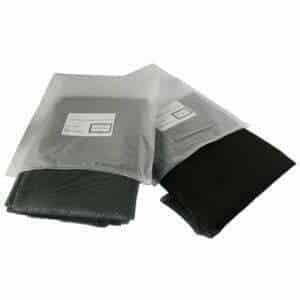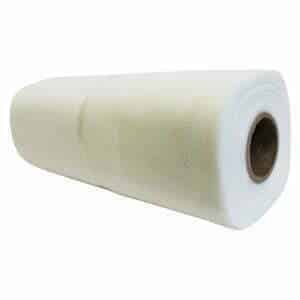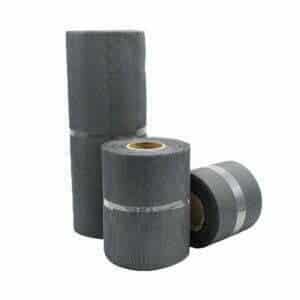







£19.99 inc VAT
Our European-crafted black fibreglass bug screen is the go-to solution for homes and buildings seeking protection against insects. Ideal for air-bricks and soffit vents, this lightweight screen efficiently blocks out birds and insects from various openings. Often chosen for window and door applications, its fibreglass composition offers durability against the elements while its black tint minimizes glare, ensuring a subtle fit. When considering our bug screen, note its specifications: a roll size of 150mm Wide x 30 Metre Length, 18 x 16 holes per linear inch, and a hole size of 1.13 x 1.31mm. Cutting to size is hassle-free with standard kitchen scissors.
✔ Always In Stock
✔ Shipped Within 24 Hours
✔ UK Delivery Included
✔ 30 Day Returns Accepted
Pay in 3 interest-free payments on purchases from £30-£2,000. Learn more
This top quality European made bug screen provides excellent netting for soffit vents. This is ideally used to block air-bricks, soffit vents etc for insect deterrent. This mesh is light but it does prevent birds and insects from gaining entry into holes, nooks and crannies. The most common use for this light mesh is as a door or window screen fly mesh.
This type of mesh is often used to keep flies and insects out of homes, buildings, and other structures.
Fibreglass insect mesh is a popular choice because it’s lightweight, easy to install, and resistant to damage from the elements. The black colour of the mesh helps to reduce glare and create a more discreet appearance when installed on windows and doors.
When purchasing a roll of black fibreglass insect mesh, it is important to make sure that the dimensions and material are suitable for your specific needs. In addition to the width and length of the roll, you may also want to consider the mesh size (i.e. the size of the holes in the mesh) and the overall strength and durability of the material.
Our group have been in the mesh industry for over 150 years. We are one of the UK’s most trusted mesh suppliers because:
The Mesh Company has an enormous range of insect mesh products. We truly are an industry leader among suppliers of weld mesh and woven wire materials. With the capabilities we have in-house, we can provide virtually anything you require.
Stainless steel, aluminium materials are also available in large stock quantities at bargain prices. See our blogs for specific information on all of our various products.
White and grey fibreglass rolls are also available, if you prefer to use those colours however black is a useful colour especially for vent mesh. This is because black doesn’t show dirt up as much as white fibreglass would.
In general, bug screens are designed to keep most insects out of your home or building. However, some insects may be able to get through certain types of bug screens, depending on the size of the mesh and the behavior of the insects.
For example, smaller insects like gnats, midges, and some species of mosquitoes may be able to get through bug screens with larger mesh sizes. Insects that are able to bite or sting may also be able to get through some types of bug screens, depending on the strength and durability of the screen material.
To ensure that your bug screen is effective at keeping insects out, it is important to choose a mesh size that is appropriate for the types of insects you are trying to keep out. Mesh sizes are typically measured in microns, and smaller mesh sizes will be more effective at keeping out smaller insects. It is also important to choose a high-quality bug screen material that is durable and resistant to damage from the elements.
Soffit vents are an important component of home ventilation systems, but they can also provide an entry point for insects and other pests. Here are some steps you can follow to bug proof a soffit vent:
Cleaning a bug screen is important to keep it functioning effectively and to prevent the build-up of dirt and debris that can attract flies and insects. Here are some steps you can follow to clean a bug screen:
If you are unable to remove the bug screen from its frame, you can still clean it using a soft-bristled brush or a vacuum cleaner with a brush attachment. Simply brush the screen gently, taking care not to damage the mesh or the frame.
Fibreglass insect mesh can generally be folded without damaging the material, but it is important to handle it carefully to avoid creating creases or kinks in the mesh. Creases or kinks can create weak spots in the mesh that insects may be able to push through.
When folding fibreglass insect mesh, it’s important to fold it along the natural lines of the mesh, rather than forcing it to bend in an unnatural direction. You should also avoid applying too much pressure or tension to the mesh, as this can cause it to stretch or tear.
If you need to store or transport fibreglass insect mesh, it is best to roll it up rather than folding it. Rolling the mesh will help to prevent creases and kinks and will help to keep the mesh in good condition for future use.
Our fibreglass and aluminium are two common materials used in insect mesh, and each has its own strengths and weaknesses.
Fibreglass insect mesh is lightweight, flexible, and relatively inexpensive. It is also resistant to rust and corrosion, which makes it a good choice for use in coastal areas or other environments where moisture is present. Fibreglass mesh is easy to cut with scissors and install by hand, and it can be painted to match the colour of the surrounding material. However, fibreglass mesh may be less durable than aluminium mesh, and it may be more susceptible to damage from wind, hail or other environmental factors.
Aluminium insect mesh is stronger and more durable than fibreglass mesh, making it a good choice for areas with high levels of traffic or where it may be subjected to heavy use or abuse. Aluminium mesh is also resistant to rust and corrosion, which makes it a good choice for use in outdoor environments. However, aluminium mesh may be more expensive than fibreglass mesh, and it may be more difficult to cut and install. Additionally, aluminium mesh may not be suitable for use in coastal areas or other environments where salt or moisture is present as it may corrode over time.
Check out our blog everything that you need to know about fibreglass insect mesh for more information on this product. Our goal for our blogs and help guides is to answer as many questions as possible to help to explain the possibilities of mesh to our customers. Contact our team today if you have any questions at all. We are always really keen to help in any way that we can.
Fence posts and tools will need to be purchased separately.
We also offer similar products through our highly popular eBay store, check us out there too.
| Fibreglass Soffit Rolls | 30 Metre x 150mm Roll |
|---|
In 2008 Locker Wire Weavers launched The Mesh Company to bring our enormous range of wire mesh products to the general public for the first time. Previously wire mesh was only available for trade customers.
We continue to extend our range, and now proudly offer many forms of mesh and metal products for the best possible prices. We specialise in woven wire mesh. As a group we work closely with architects and designers to develop ground-breaking new applications for our multifunctional range of materials. We also offer state of the art fabrication and engineering for projects of all sizes.
Strong ties with the Warrington community continue to be at the very core of our business. We are proud to invest in the training and developing our staff of all levels in line with the traditions set by Thomas Locker, who founded our group 150 years ago when he invented the electronic loom. We continue to bring ingenuity and strong ethics to our day to day business.
The Mesh Company continues Warrington’s historic role in the wire industry. For more than 140 years, our group has been a leader in the supply and manufacture of woven wire mesh and wire cloth. Having been founded in Warrington, UK in 1878, Locker mesh products still retain the quality craftsmanship and spirit of innovation that were so characteristic then.
Available Options
You will find full rolls of this insect netting here. Please be advised that the majority of woven mesh is usually available in a maximum roll size of 30 metres by 1200mm. Please email us if you wish to discuss purchasing this mesh in any size – sales@themeshcompany.com.
Feel free to call us if you wish to discuss any of our products – (+ 44) 01925 406 602. We are always happy to help in any way that we are able to.
We also offer this product through our highly popular eBay store, check us out there too.




The largest range of wire mesh, chicken wire, wire fencing, woven wire mesh and perforated metal products in Europe, delivered direct from our Warrington warehouse.




Website by: Beech Web Services | Terms and Conditions | Cookie Policy | Privacy Policy | Website Terms and Conditions
Reviews
There are no reviews yet.